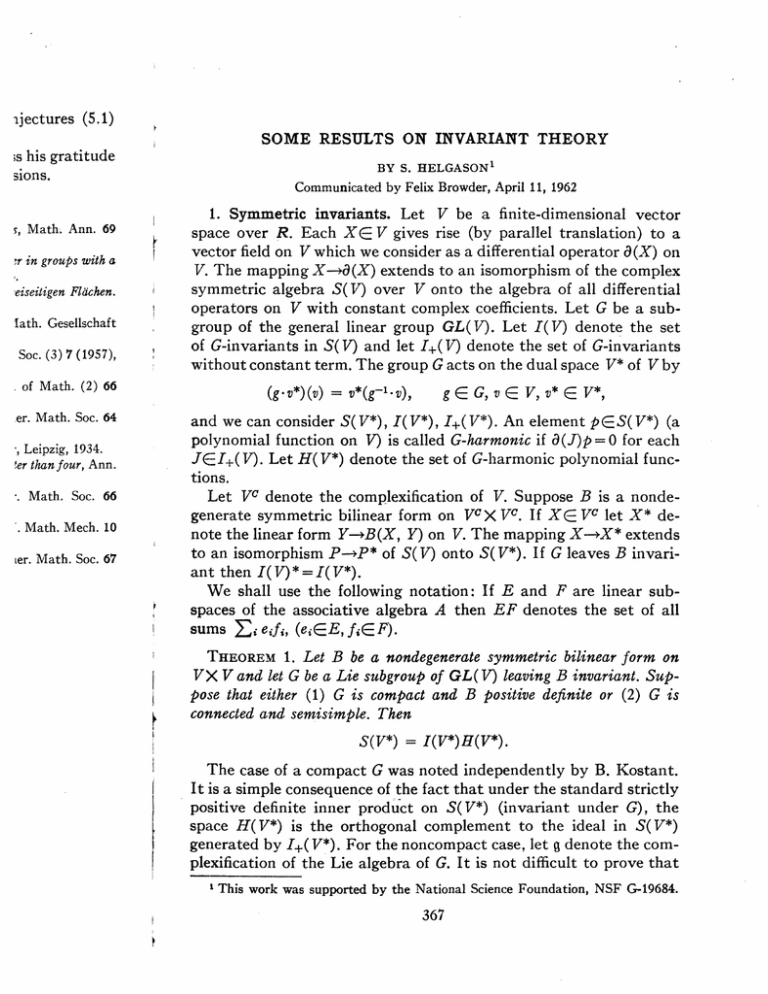Symmetric R.
advertisement

ijectures (5.1)
SOME RESULTS ON INVARIANT THEORY
;s his gratitude
sions.
Y,
BY S. HELGASON
1
Communicated by Felix Browder, April 11, 1962
1. Symmetric invariants. Let V be a finite-dimensional vector
space over R. Each XE V gives rise (by parallel translation) to a
Math. Ann. 69
vector field on V which we consider as a differential operator d(X) on
'r in groups with a
V. The mapping X-->(X) extends to an isomorphism of the complex
symmetric algebra S(V) over V onto the algebra of all differential
eiseitigen Flachen.
operators on V with constant complex coefficients. Let G be a sub-
lath. Gesellschaft
group of the general linear group GL(V). Let I(V) denote the set
of G-invariants in S(V) and let I+(V) denote the set of G-invariants
without constant term. The group G acts on the dual space V* of V by
Soc. (3) 7 (1957),
of Math. (2) 66
(g. v*)(v) = v*(g-l'v),
er. Math. Soc. 64
g E G, v
V, v*
V*
and we can consider S(V*), I(V*), I+(V*). An element p
S(V*) (a
polynomial function on V) is called G-harmonic if (J)p=0 for each
, Leipzig, 1934.
JC-I+(V). Let H(V*) denote the set of G-harmonic polynomial functions.
Let VCdenote the complexification of V. Suppose B is a nondegenerate symmetric bilinear form on VX V. If XC VC let X* denote the linear form Y--B(X, Y) on V. The mapping X--X* extends
to an isomorphism P--P* of S(V) onto S(V*). If G leaves B invari-
!erthan four, Ann.
. Math. Soc. 66
. Math. Mech. 10
ler. Math. Soc. 67
ant then I( V)*= I(V*).
i
I
i
We shall use the following notation: If E and F are linear subspaces of the associative algebra A then EF denotes the set of all
sums
i eif,, (eiGE,fi F).
THEOREM
1. Let B be a nondegenerate symmetric bilinear form on
VX V and let G be a Lie subgroupof GL( V) leaving B invariant. SupI
i
i
pose that either (1) G is compact and B positive definite or (2) G is
connected and semisimple. Then
S(V*) = I(V*)H(V*).
The case of a compact G was noted independently by B. Kostant.
It is a simple consequence of the fact that under the standard strictly
positive definite inner product on S(V*) (invariant under G), the
space H(V*) is the orthogonal complement to the ideal in S(V*)
generated by I+( V*). For the noncompact case, let g denote the complexification of the Lie algebra of G. It is not difficult to prove that
'This work was supported by the National Science Foundation, NSF G-19684.
367
21 a
T
Axea!un al:; &/ aAo A ameds 1o:3aA ieuo!suau!p-uZ e s y 2/u!ap!s
la'-I 'uaiavx2
-uoD ' Jxao aaeds ;.aql!H I uo!suaump-u ue aq
adu!s
'
vulss
'(*A)a V (VA)r= (*A)V
a
,ounf 2vUOyD27
1) 0 w7
uaytL '1 ua9oaLL;u. so aq suo lJufnsso atyj7I7 'E tI7aoaHL
(!!!)
' 9 a=n sl
Sqa9lv
(!) Jvd (!)
s4uouaIa a!!!tud-
o as aq; a:ouap (A)r
a-I
("X v.
iaqtuatu asoq.
e paq!losap aq
*(A)+ r r qaea oj 0 = 4(f') J! atl.uz.C4-DPalTeas! (*A)VE 4:uamala
u 'uusa ue suoo no'IqP supeAu!
o sas aq (A)+- puu (A)+r
V
a:ouop (,A )r
'Xla! dsl '(*A )V pue (AV UTSUVlUAU!-.A JO aSS aSO
pu (A)/ aq (A)70 Jo dnoJiqns Aue aq D aI '(*A)V jo sus!qd
-Joluopua IIu Jo 1iqale aq; o:u! (A)V jo us zsousos u o: Alanbiun
aaxqL
spua~xa (X)<--X 2uiddewu aq L 'x o uo!ss!Luo sale!putUy
uoBT1!JsaJ atq:
:)[r S4VUS -f
us AU2D 8 pUS
:q)I sdetu /--/
a.leAUt Jo sas
)A4 put ()M
I qo3tAI
X
v
-y
v..
V x)(x)xI+v( -- )
= (x V ·.
V
Tx).(x)
14
.f
AquaA!A (,A )V jo (X)9 UO!ATJpaP!Ue ue saonpu. A 3X
qetg
UT
'*A puu A saveds Jo:3oa jenp
j
aq41aAO sJqaIe
uueUssSe13
aq
aouap 'lafA!a dsoa '(*A )V pue (A)V pa'I suTIxAua louaxH
eau!T Jo dnoi2
n UT
al
tlmIY
'Z
0 = (*A)ZH IT1- zles
eauTl o dnoiJ
31eqns ue!taqe
euI e aq 4t pq'
2T Ja
-uallajsIfnN
s,:aaql!H
UOaJ
AI!sea SAIOlOJ ! (u)O =;D aseu alq Io-
DN uo IClltN.uap :lssu a ofl~Zaz
Slv.uou
-4Co49tuoulaD-9O fo as 911 s (A)zH puv (NX
· · · 'Z 'I '0=
/)
',(*X) s2LuouICo4 a cq pauuv4s aoD4s 4ooana all s (*A)H aao1i.
'p M14
, ou! n jo UOT4
'(*A )=H+ (A)H
I laAo viqaIje
tresvXAUI
= (A)H
ufns oap
*
l s.
fo (oA Ut) so19Z uousWo: fo 9asa9ll
(*A)H uafJ '(*A )+I ut Sluu9a9aa S911
9aouap oN 197 1'ua9oati f U SD aq suo41unssS agil7a?7 'Z aa7oa L
'([9Z 'd
V4wq:a aJaqm
:SPIOtI
-'zjIeJaua
UD
'
'
UOT1
+ D 'T9
'I '0= pu? O=ZV+ ...
aqL '
2uTMiolloJ
,(("x"V+ · · · +TxTV) si?!tUouA l od aq4, Aq pauueds
ataq
asO sll u! st. (A)H :rq; ([6] sseIAIV'[S8Z d 'Z] ueieD arJdtuo3)
~/(gx+ ... +1 x) " =4
Iaralt
UmOU~
I osjl s! I o!uotuJeq s l tqyea
u8a (*A)V3a
.axod
s:! pue
Ua44TM. aq Ur (
saDnpaJ T uaJoaqj
(*1)H
=4 qvea
t etqej e IjSSe'e aq o4
' . . 'TX)4=4
s!uouAlod
D!uotuaeq Aaiu!pio ayq Iie jo s!sTSuo
II jo SS!SUoO (A)I
uaq;
pUB zX+ · · · +
TX
U SI!TOUAiOd
.,V =A uo lut eD (u)o dnoJaf Piuo~oq.o aqI s! 9 uaqnMaseo aq u I
-'A uo n o uoio-eoaq o: poTidds
aq uo ase ;3edwoo aqTjMON 'aTuyap aA!Hsod I3T!Js S! ff q3IqAx uo
aj :DdtLuoo qaea
oA. JO MtuIoj IaI e aU!eAU SAal B Jo it uuoj
'A 0 U" '"X
'1G 'Xi'
X
q (X=uZ
adno
.q (u)/2 dnofl
qnf]
[r96I
NOSVO3'IHH 'S
89
r
[July
orm W of Vc
ct case can be
ing on V= Rn
I 962]
Let NG denote
. Then H(V*)
369
group U(n) becomes a subgroup G of the orthogonal group 0(2n).
Let Zk = Xk +i Yk (1 _ k _ n) be an orthonormal basis of E and let
xl, y1, · · · , xn, yn be the basis of V* dual to the basis X1, Y1, · · ,
X,, Yn of V. It is easy to show that the element
.2 and H(V*)
rem 1 reduces
n be written
is also known
is in this case
·e a, · - · , an
ig generaliza-
SOME RESULTS ON INVARIANT THEORY
n
u = E xk A yk
2
1
and its powers form a basis of J+(V*). In view of Theorem 3 each
vGA(V*) can therefore be written
v=
E uk A Pk,
k
where each Pk satisfies
p. 26]).
(u)k=0,
(compare Weil [10, Theoreme 3,
.3. Invariants of Weyl groups. Let u be an arbitrary semisimple Lie
algebra over R whose adjoint group U is compact. Let 0 be an arbitrary involutive automorphism of u and let u = f+p be the decomposiomials (X*)k,
tion of u into eigenspaces of 0 for the eigenvalue +1 and -1 respec-
armonic poly-
tively. Let K denote the analytic subgroup of U corresponding to .
s Nullstellen-
Let bpbe a maximal abelian subspace of and extend fp to a maximal
of ut. The Weyl group of is defined as the
abelian subalgebra
group of linear transformations of
in U which leave
Lively, denote
and V*. Each
3y
kA.
A x,)
induced by the set of elements
invariant; the Weyl group of fp is defined as the
group of linear transformations of fp induced by the set of elements
in K which leave bp invariant. Let these groups be denoted by
W(b))and W(bp) and let I(b*) and I(tb*) denote the corresponding
sets of invariant polynomial functions. It is known that W(bp) can
be described as the group of linear transformations of bpinduced by
those members of W(b) which leave b%invariant. Consequently, if
the restriction to bpof a function f on
is denoted by , the mapping
,8(X) extends
all endomorLet J(V) and
f--f mapsI(1*)intoI(p).
, respectively,
rant term. An
and 0 any involutive automorphism of u. Then the restriction mapping
Lch JGJ+(V).
'THEOREM
4. (i) Suppose u is a classicalcompact simple Lie algebra
f-f maps1(*) ontoI(*).
(ii) Part (i) does not hold in general for the exceptional simple Lie
algebras u = e, e7, e.
Then
(iii) Let Q(b*) and Q(b*), respectively, denote the set of invariant
rational functions on
and bp. Under the restriction mapping f--f,
Q(b*) is mapped onto Q(*p).
over C. Con-
R the unitary
+ip is the most general semisimple Lie algebra over R. Parts (i) and (ii) above therefore express
IREMARKS.
As u and 0 are arbitrary,
'V
T
iqale
Jo
anpaaoJd sqL '
sie
a
asea aq o panpaa aq uea ase sqg (b ')O
aq; J o uogeai3 xaIduLoa aq4 o uxioj [eai 4edotuo
e Jo asn Xq pue paeduo s () u ioeuluouap a '= =4I
'Z
'[t u/cO
pue [91 aaaH Aq pOaoJd .peaie se
0oj)0= b asez ie!1ads aqjL '1 'saxIava3t
JLtSnH3aSSV IA
VA '9A
(paedtuo
'0I
'6I
s (b ')o
'
(b+dX '
· b'd
, 'sseelt 'H '6
uos. uvapt.pn-uou
'auXao '3 '8
qpqp
=f
*5'd
' 9
amnss
I) 6 PUe3 S 'Y1,Ae
Uose0laH S L
'*0"-86g
!2'a39H 'a '9
UO
lvq zgns
T x)j=gjr ImnouICloc4 sstxa 9a9aziua/J1 *( ')
( '4)
uo uotpunf
louaugvpunf D oq f la? S3 aaIoaaHJ,
aAeq a
pueq aqgo aql u o uovpunj Iesuauepun eI sTb'd 0o d JOuopo4saJ
aq: uLaq ie!tuouAlod s (+dX ' · 'Ix)dj=j j! eq snoAqo ST1I
)FE-66Z '(OS6T) IS
mq-qs/ H
'S
Z8L-LL '(SS61) tL
;aIlaAoD '
'V
(b' -
rb.~austs uumuo.Žt
)0 (b ')o = D3
uopeaygu;ap!P aq aeu
'TF61
9597 '
'Z
a
Jo
31q4 SolIOJ
I
ogienba aq4 2ui
6dX _ . . _ I X _ dX$ . +
5-
4J)
'T
· epue4-qsite
aas)
peq (!)
uoTpeWuasaidaJ
'(I 'Z)O dno/S
qL Jo asn a4evu
aq
10J P10lo
= (b ')
(I)
a
os
(b '-4)o
o0 3qdJotuos s pax ( ' '
'O 'I) 2unAial dnolgqns
aq pue '5d UO alA4!su UJ4 s3a ( '4)O dnoAi. aqjL '4UpTAUI 0 SUT
-Aeal b+d jO SUOT.1poJSUe?.
aieauTI jo dnoJ a aouap ( ') 0 aq
tvlualUvpuof9anol
'uaeD1'3
*' I
'(0
Luat a4luTapu
aaeld1e
X-
uoipenba alyt Xq uaA2 b+dd '
aTupenb aq/ lap!suoD
·IeUO!S
um!p-a4!uJ S (3-x)
J
suo!maunJ aq4 Aq pauueds D .aaO A aeds .loa3
a
J1 ([81Z 'd
'] u4eDe) lviauvmvpunf palle s! f uo43unj a L '(O93) (Hx)f=
(H)-,f Aq uaAxTH/9 uo uop3unJ aq saouap / uaql 93X pue HID/;
uo uo!gaunJ snonupluoa panleA-xalduuoa e s f jjI Aolodo4 Ienuu
aT:J '-!ax H saso0 4aI Jo as aq; H/D 'dnoJiqns pasoPl e H 'dnoa3
elzo 1odo4 e aq
a- spunb
uo suo;opun; Iljuampung
'I,
5 ')0 ue aq o4
aqjL LUoj{ f7
'-S!laeH
I
xe.d
H
Aq puaXpuadapui paaoid uaaq
uoq3IalSa1 Xq (*q()I TUOJipaure4qo aq 4ouupea qzalqt
'AlaA!4asdsaai '9 pue ' ' aa1Jap Jo wuamla snoauagoumoq e sue4uoa
8
(*t)I .u!l aql '((Z)nsX)/
s io (LX 9 )/L '1 /9 3 si y/
aaeds
aq:l ! 4Teqp
punoj uaql st 41 'slp uou:I woil pauwulagap A1 pea aq
uea sloeWJauagaql Jo saaaap aqL '([t] aliepaq) 's3u!p iemiou.iod
a4l XAq
T= CxTx+x
ase
aie (*q)I pue ( )I suo!3aalpi q pavleaua2 sdnol auy ae (q)A
(q)A sdnoJi aq au!iS
'y/
2 aeds 3alatuuwSs aql Jo pue / Jo
{au e Agt '
to- aq4 Jo saJnl
(b '4) ase aqL
1 = b ioj
sneaq
pu
saJnl4nljs 4l00 al JO [ I] Uolv3gJISSelz s,ue4.eD 2uisn U04eg!ylaA Xq
paAoid s! () lecTd 'Ig .aa siqagle aq aldUws II e io ploq o4 sIWeJ aX
e Aq paleqs s! qaIiqmAXLadoIde
' Jaao sqaple
aj ajldtus zVi.ssvp 11i
Xlnfi
[Z96I
NOSVDYIH 'S
O04
[July
yebras over R,
t (i) is proved
'oot structures
.ps W(Ib) and
and I(D*) are
,enerators can
nd that if the
the ring I(t)
respectively,
371
SOME RESULTS ON INVARIANT THEORY
I962]
for q= 1 because 0(1, 1) is not semisimple and the theorem fails to
shows.
hold for (p, q)=(1, 1) as the example f(xi, x2) =cosh-'(lxjl)
The case (p, q)= (1, 2) was settled by Loewner [8] using special fea-
tures of the Lobatchefsky plane.
3. By a method of descent the remaining cases can be reduced to
the case x +x2-A3 = 1 (which differs radically from the case x --x
-x 3 = 1 by the noncompactness of the isotropy group). Here one can
make use of the special property of the identity component of the
group 0(2, 1), namely that every representation of it extends to a
Part (iii) had
representation of the corresponding complex subgroup of GL(3, C),
(see Harish-Chandra [5]).
a topological
4. From Theorem 1 it is clear that the polynomial P can be taken
to be an 0(p, q)-harmonic polynomial, that is a polynomial satisfying the equation
s gH with the
ts function on
/ r2
.ven by fz(gH)
zl (Cartan
[3,
the functions
d2
1...-[.
Ox1
042
2
02
Ox 2+ 1
\
P=0.
.
X
It follows that the function f is necessarily a sum of eigenfunctions
of the Laplace-Beltrami operator on C,,q (formed by means of the
indefinite Riemannian metric on C.,,,, [7]).
(P
3
~! 1 q -z= ).
of RP+ q leav-
n C,q and the
to (p-1, q)
BIBLIOGRAPHY
1. . Cartan, Sur certaines formes riemanniennes remarquables des gomtries a
groupefondamental simple, Ann. Sci. Acole Norm. Sup. 44 (1927), 345-467.
2.
, Lemons sur la gomdtrie projective complexe, Gauthier-Villars, Paris,
1931.
, Sur la determination d'un systeme orthogonalcomplet dans un espace de
3.
Riemann symdtrique dos, Rend. Circ. Mat. Palermo 53 (1929), 217-252.
4. C. Chevalley, Invariants of finite groups generatedby reflections,Amer. J. Math.
)mial then the
:he other hand
Cp,,q. Assume
Xi,
'' , Xp+q)
on C,q.
q) is compact)
77 (1955), 778-782.
5. Harish-Chandra, Lie algebrasand the Tannaka duality theorem,Ann. of Math.
51 (1950), 299-330.
6. E. Hecke, Uber orthogonalinvarianteIntegralgleichungen,Math. Ann. 78 (1918),
398-404.
7. S. Helgason, Some remarks on the exponential mapping for an affine connection,
Math. Scand. 9 (1961), 129-146.
8. C. Loewner, On some transformation semigroups invariant under Euclidean and
non-Euclidean isometries,J. Math. Mech. 8 (1950), 393-409.
9. H. Maass, Zur Theorie der harmonischen Formen, Math. Ann. 137 (1959) 142149.
10. A. Weil, Varitts Kahleriennes, Hermann, Paris, 1958.
MASSACHUSETTS
d by use of a
_ie algebra
of
procedure fails
INSTITUTE OF TECHNOLOGY


